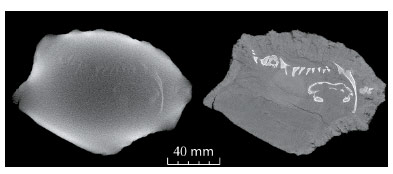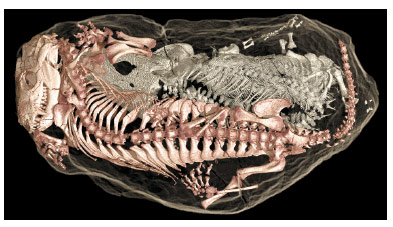- Home
- Users & Science
- Scientific Documentation
- ESRF Highlights
- ESRF Highlights 2013
- X-ray imaging
- Oddest couple ever found
Oddest couple ever found
Burrowing is a widespread activity in the animal kingdom that is used for a great variety of reasons such as predator protection or food hoarding. In hostile environments, adaptation to a fossorial lifestyle is crucial as it provides a more stable environment throughout the year. The numerous fossilised burrow casts from the Permo-Triassic period (~ 252 Million years ago) of South Africa are viewed as a response by terrestrial tetrapods in order to survive the harsh climatic conditions following the mass extinction event that occurred at the end of the Permian period. A few therapsids (forerunners of mammals) have been discovered in fossilised burrow casts, documenting the importance of fossorial lifestyles in this lineage for overcoming harsh climatic conditions. However, while hundreds of fossilised burrow casts have been reported from these rocks, relatively few studies have been undertaken on them as the information required is hidden within rock. The traditional protocol, until now, has consisted of cracking open the burrow casts and, if fossilised skeletal material was preserved, removing the rock of the cast to expose the encased bony elements.
The use of X-ray tomography as an alternative non-destructive extraction protocol for these types of studies is a solution that enables the investigation of the entire burrow cast. A sample investigation performed using laboratory X-ray sources, however, was limited by the lack of contrast between sediment and fossilised bones (Figure 15). Propagation phase contrast synchrotron microtomography has overcome this problem and made it possible to visualise the contents of a burrow cast as large as 18 cm in diameter. We used the microtomography set-up at beamline ID17 which produced a wide and highly energetic monochromatic beam with a long propagation distance. In addition, we used attenuation and half-acquisition protocols [1,2].
 |
|
Fig. 15: Comparison of a virtual transverse section of the burrow cast obtained from a laboratory micro-CT (left) and from the ID17 beamline (right). Fossilised bones appear in white. |
The first experiment of this kind on a fossilised burrow cast revealed the skeletons of the fox-sized mammal-like reptile Thrinaxodon and temnospondyl amphibian Broomistega (Figure 16). Full segmentation of both skeletons showed that the two animals were buried together at the terminal end of the burrow. The study of the sedimentological pattern indicated that the two animals most likely died from a series of rapid flood events that filled the burrow. It appeared that neither animal was flushed into the burrow by the flooding event, rather they were both present before the flood.
 |
|
Fig. 16: Three-dimensional rendering of the Thrinaxodon (light brown) and the Broomistega (green) enclosed in the burrow cast. |
We investigated possible reasons for such an odd cohabitation of two animals with a similar diet and similar body size. Close examination of the skeleton of the Broomistega showed a series of seven broken ribs on the right side of the animal. As some of these fractures were healed or healing, it was clear that this trauma occurred before the flooding event and was not directly related to the death of the animal. As Broomistega was primarily an aquatic creature, we concluded that it probably used the burrow as a temporary shelter because its injury would not have permitted rapid escape from predators while on land.
Comparison with examples of modern burrow-sharing of different species led to the conclusion that tolerance of the visitor by the host was driven by exceptional conditions. As several Thrinaxodon specimens have previously been discovered in curled-up positions and also preserved within burrow casts, it was hypothesised that this animal was aestivating in burrows during arid parts of the year. Experiencing deep torpor may explain why so many individuals of this species have been buried in such a resting posture. Discovery of this exceptional cohabitation corroborates this hypothesis, documenting how our very distant ancestors may have adapted to harsh climatic conditions and lack of food and water resources, successfully surviving the most calamitous mass extinction event in the history of life on Earth.
Principal publication and authors
V. Fernandez (a), F. Abdala (a), K.J. Carlson (a,b), D. Collins Cook (b), B.S. Rubidge (a), A. Yates (a,c) and P. Tafforeau (d), PLoS ONE 8, e64978 (2013).
(a) Evolutionary Studies Institute, University of the Witwatersrand (South Africa)
(b) Department of Anthropology, Indiana University (USA)
(c) Museum of Central Australia, Alice Springs (Australia)
(d) ESRF
References
1] K.J. Carlson, D. Stout, T. Jashashvili, D.J. De Ruiter, P. Tafforeau, K. Carlson, L.R. Berger, Science 333, 1402-1407 (2011).
[2] S. Sanchez, V. Fernandez, S.E. Pierce, P. Tafforeau, Nature Protocols 8, 1708–1717 (2013).



